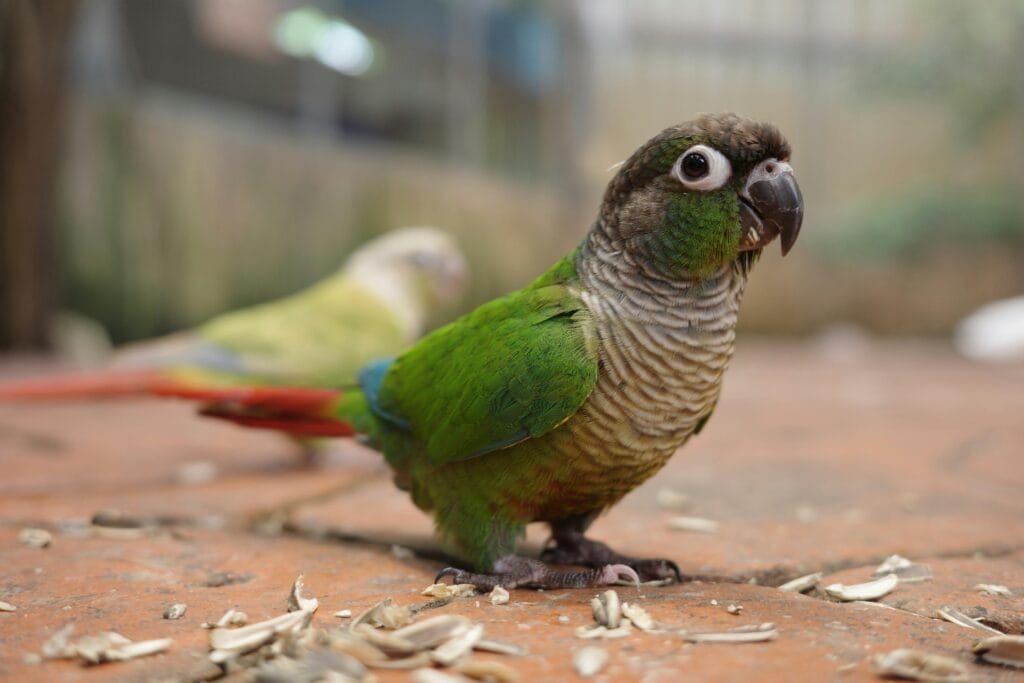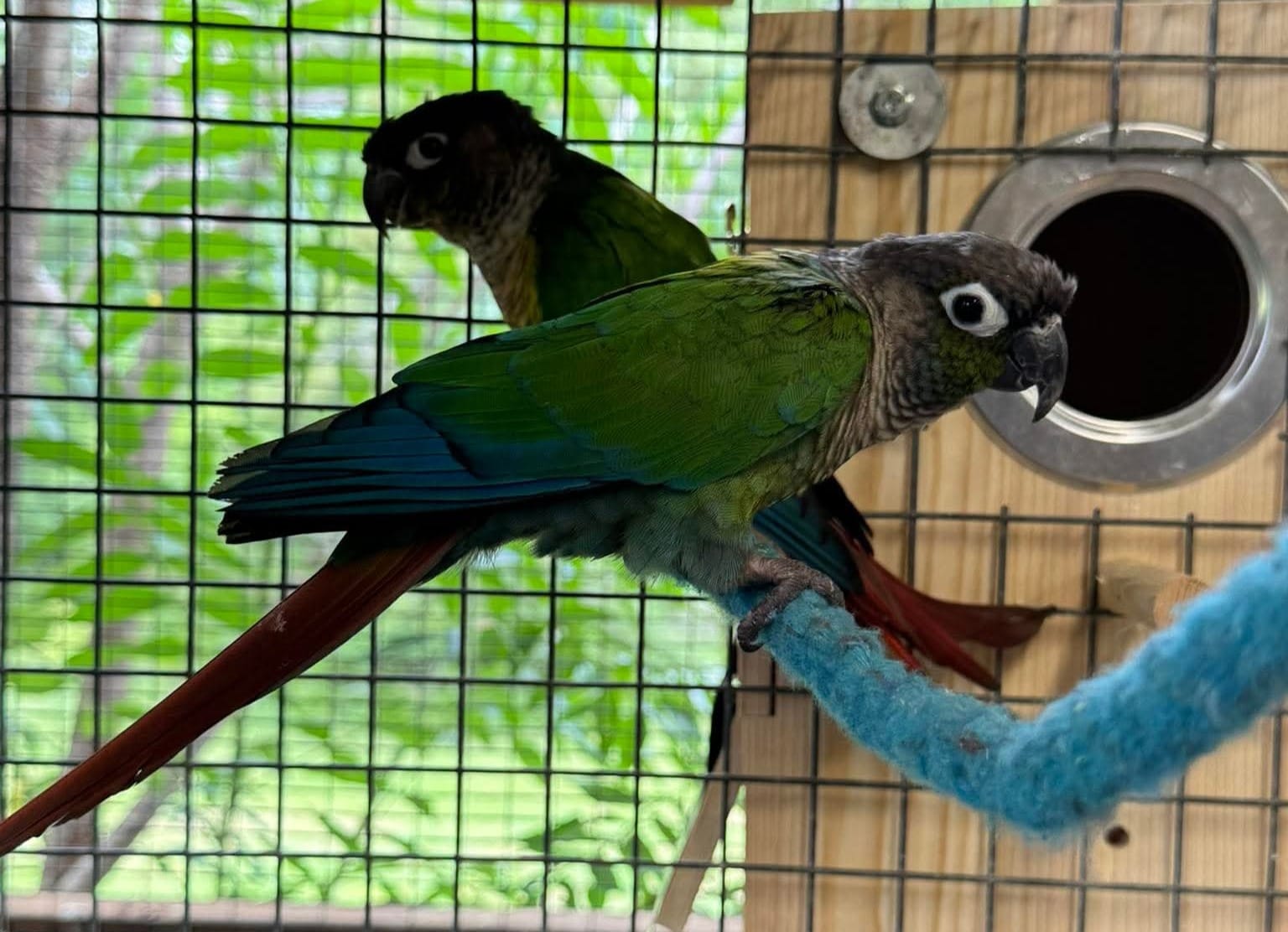Green Cheeked Parakeet: What Does Your Bird Really Need to Stay Happy?
Green cheeked parakeets are among the most charismatic and intelligent companion birds in the avian world. These diminutive dynamos pack enormous personality into their compact frames, making them increasingly popular among bird enthusiasts worldwide. Understanding proper care techniques for your green cheeked parakeet ensures a thriving relationship that can span decades.
Native to South America’s lush forests, these vibrant creatures have adapted remarkably well to domestic environments when provided with appropriate care. Their playful nature, combined with impressive cognitive abilities, makes the green cheeked parakeet an exceptional choice for both novice and experienced bird keepers.
Table of Contents
Green Cheeked Parakeet:

Understanding Your Green Cheeked Parakeet’s Natural Behavior
Origins and Wild Habitat
Green cheeked parakeets originate from the dense rainforests of Bolivia, Brazil, Argentina, and Paraguay. In their natural habitat, these social creatures live in flocks ranging from small family groups to massive congregations of hundreds of individuals. This gregarious nature significantly influences their domestic behavior patterns and social requirements.
The species thrives in humid, tropical environments with temperatures ranging from 70-85°F and humidity levels between 50-70%. Understanding these natural preferences helps create optimal captive conditions that promote health and happiness in your green cheeked parakeet.
Physical Characteristics and Identification
The green cheeked parakeet displays distinctive coloration that makes identification straightforward. Their predominantly green plumage features darker flight feathers, while their cheeks showcase the characteristic green coloring that inspired their common name. Adult birds typically measure 10-11 inches in length and weigh between 60-80 grams.
Color mutations have emerged in captivity, including cinnamon, yellow-sided, pineapple, and turquoise variations. These mutations create stunning visual diversity while maintaining the species’ characteristic personality traits and care requirements.
Intelligence and Communication Abilities
These remarkable birds demonstrate exceptional problem-solving skills and can learn extensive vocabularies. A well-socialized green cheeked parakeet often develops sophisticated communication patterns with their human companions, including mimicking household sounds, learning words, and even understanding contextual usage of certain phrases.
Research indicates that green cheeked parakeets possess intelligence levels comparable to young children, capable of learning complex behaviors, solving multi-step puzzles, and forming emotional attachments to their human caretakers.
Smart Care Tip 1: Creating the Perfect Living Environment
Cage Size and Configuration
Providing adequate space represents the foundation of proper green cheeked parakeet care. The minimum cage dimensions should measure 24 inches wide, 24 inches deep, and 30 inches high for a single bird. However, larger enclosures always prove beneficial, as these active birds require substantial room for exercise and enrichment activities.
For multiple birds, increase cage size proportionally to prevent territorial disputes and ensure adequate personal space for each individual. A flight cage measuring 32 inches wide by 24 inches deep by 40 inches high accommodates two birds comfortably.
Bar Spacing and Safety Considerations
Optimal bar spacing for your green cheeked parakeet cage should measure between 1/2 to 5/8 inches. This spacing prevents escape while ensuring your bird cannot trap their head or limbs between bars. Horizontal bars facilitate climbing, which satisfies their natural arboreal instincts.
Stainless steel or powder-coated cages provide the safest options, avoiding galvanized materials that may contain toxic zinc. Inspect welds regularly for sharp edges or potential hazards that could injure your green cheeked parakeet.
Location and Environmental Factors
Position your green cheeked parakeet’s cage in a socially active area of your home while avoiding direct sunlight, drafts, and temperature fluctuations. These birds thrive on interaction and prefer observing household activities from their secure vantage point.
Maintain consistent temperature ranges between 65-78°F with humidity levels around 50-60%. Provide 10-12 hours of darkness nightly for proper rest cycles, using cage covers or dimming lights to simulate natural day-night patterns.
Essential Cage Accessories
Equip your green cheeked parakeet’s habitat with natural wood perches of varying diameters to promote foot health and prevent arthritis. Include food and water dishes made from stainless steel or ceramic materials that resist bacterial growth and are easy to clean.
Position perches at different heights throughout the cage to encourage movement and exercise. Avoid placing perches directly above food or water dishes to prevent contamination from droppings.
Smart Care Tip 2: Nutritional Excellence for Optimal Health
Balanced Diet Fundamentals
A nutritionally complete diet forms the cornerstone of green cheeked parakeet health. High-quality pellets should comprise 75-80% of their daily intake, supplemented with fresh vegetables, limited fruits, and occasional healthy treats. Avoid seed-only diets, which lack essential nutrients and promote obesity.
Select pellets specifically formulated for conures and small parrots, avoiding generic bird food that may not meet species-specific nutritional requirements. Organic, dye-free pellets provide the highest quality nutrition without unnecessary additives.
Fresh Foods and Variety
Incorporate diverse fresh foods into your green cheeked parakeet’s diet, including leafy greens like kale and spinach, orange vegetables such as carrots and sweet potatoes, and calcium-rich options like broccoli. Rotate offerings regularly to prevent dietary boredom and ensure comprehensive nutrition.
Safe fruits include apples (seeds removed), berries, grapes, and melons in moderation. Introduce new foods gradually and monitor acceptance, as individual preferences vary significantly among green cheeked parakeets.
Feeding Schedule and Portion Control
Establish consistent feeding schedules with fresh food offered twice daily and pellets available continuously. Remove uneaten fresh foods within 2-4 hours to prevent spoilage and bacterial growth that could cause illness.
Monitor daily food consumption to identify changes in appetite that might indicate health issues. A healthy adult green cheeked parakeet typically consumes 1-2 tablespoons of pellets plus fresh foods daily.
Foods to Avoid
Certain foods pose serious health risks to your green cheeked parakeet. Never offer chocolate, avocado, caffeine, alcohol, onions, garlic, or foods high in salt, sugar, or fat. These substances can cause severe illness or death in birds due to their sensitive digestive systems.
Additional toxic foods include fruit pits, apple seeds, mushrooms, and raw beans. When in doubt, research thoroughly before offering new foods to ensure safety for your green cheeked parakeet.

Smart Care Tip 3: Mental Stimulation and Enrichment
Toy Selection and Rotation
Mental stimulation prevents behavioral problems and promotes psychological well-being in your green cheeked parakeet. Provide various toy types including puzzle feeders, shredding materials, bells, and interactive challenges. Rotate toys weekly to maintain novelty and prevent boredom.
Safe toy materials include untreated wood, natural fibers, stainless steel bells, and bird-safe plastics. Avoid toys with small parts that could be swallowed, toxic materials like lead or zinc, or items with loose strings that pose entanglement risks.
Foraging Opportunities
Implement foraging activities that mirror natural feeding behaviors. Hide treats within paper cups, wrap food in safe materials, or use commercial foraging toys. These activities engage your green cheeked parakeet’s problem-solving abilities while providing rewarding mental exercise.
Create foraging challenges by placing food in different locations throughout the cage, encouraging natural searching behaviors. Vary difficulty levels to maintain interest and prevent frustration while building confidence through successful completion.
Training and Socialization
Regular training sessions strengthen the bond between you and your green cheeked parakeet while providing mental stimulation. Start with simple commands like “step up” and gradually progress to more complex tricks. Positive reinforcement techniques work exceptionally well with these intelligent birds.
Use favorite treats as training rewards, keeping sessions short (5-10 minutes) to maintain attention and prevent frustration. Consistency and patience yield the best results in green cheeked parakeet training programs.
Environmental Enrichment Strategies
Change cage layout periodically to provide new exploration opportunities for your green cheeked parakeet. Rearrange perches, relocate toys, and introduce new textures to stimulate curiosity and prevent cage-bound behaviors.
Provide supervised access to safe household items like cardboard boxes, paper towel tubes, and wooden spoons for additional enrichment opportunities outside regular cage accessories.
Smart Care Tip 4: Exercise and Physical Activity
Out-of-Cage Time Requirements
Your green cheeked parakeet requires several hours of supervised out-of-cage time daily for proper exercise and social interaction. This freedom allows natural behaviors like flying, climbing, and exploring while strengthening your relationship through shared activities.
Establish consistent out-of-cage schedules to help your green cheeked parakeet anticipate and prepare for exercise periods. Gradual increases in freedom duration allow birds to adjust comfortably to expanded territories.
Creating Safe Play Areas
Establish designated play areas outside the cage where your green cheeked parakeet can exercise safely. Remove potential hazards like toxic plants, open water containers, ceiling fans, and other pets. Provide climbing structures, perches, and toys to create engaging play environments.
Bird-proof rooms by covering mirrors, securing loose cords, and blocking access to small spaces where your green cheeked parakeet might become trapped. Supervision remains essential during all out-of-cage activities.
Wing Clipping Considerations
Wing clipping remains a controversial topic among green cheeked parakeet owners. While some prefer allowing natural flight capabilities, others choose light clipping for safety reasons. Consult with an avian veterinarian to determine the best approach for your specific situation and environment.
Properly clipped wings should allow controlled gliding rather than complete flight restriction. Excessive clipping can cause injuries from hard landings and psychological stress from inability to escape perceived threats.
Exercise Equipment and Accessories
Provide climbing gyms, rope perches, and play stands to encourage physical activity during out-of-cage time. These accessories satisfy natural climbing instincts while providing safe exercise opportunities for your green cheeked parakeet.
Rotate exercise equipment regularly to maintain interest and challenge different muscle groups. Varying heights and textures promote comprehensive physical development and prevent repetitive strain injuries.
Smart Care Tip 5: Health Monitoring and Veterinary Care
Regular Health Assessments
Monitor your green cheeked parakeet’s health through daily observations of appetite, behavior, droppings, and physical appearance. Healthy birds display bright eyes, smooth feathers, active behavior, and consistent eating patterns. Document any changes in a health journal for veterinary reference.
Weigh your green cheeked parakeet weekly using a gram scale to track weight fluctuations that might indicate health issues. Sudden weight loss often signals illness before other symptoms become apparent.
Common Health Issues
Green cheeked parakeets are susceptible to several health conditions including psittacosis, aspergillosis, and nutritional deficiencies. Early detection and treatment significantly improve outcomes, making regular veterinary checkups essential for maintaining optimal health.
Respiratory infections, feather plucking, and gastrointestinal disorders also occur commonly in captive green cheeked parakeets. Environmental stress, poor nutrition, and inadequate hygiene contribute to many preventable health problems.
Finding Qualified Avian Veterinary Care
Locate certified avian veterinarians in your area before acquiring your green cheeked parakeet. These specialists possess the knowledge and equipment necessary for proper bird care, including diagnostic tools and treatment protocols specific to avian medicine.
Schedule annual wellness examinations even for apparently healthy birds, as early detection of problems significantly improves treatment success rates. Establish relationships with veterinary professionals before emergencies arise.
Emergency Preparedness
Maintain an emergency kit containing your veterinarian’s contact information, after-hours emergency clinic details, and basic first aid supplies. Green cheeked parakeets can deteriorate rapidly when ill, making quick access to professional care potentially life-saving.
Learn to recognize emergency symptoms including difficulty breathing, bleeding, seizures, or inability to perch. These situations require immediate veterinary attention regardless of time or day.

Smart Care Tip 6: Building Strong Social Bonds
Daily Interaction Requirements
Green cheeked parakeets are inherently social creatures requiring substantial daily interaction with their human family. Dedicate time each day for talking, training, and playing with your bird to prevent loneliness and behavioral issues.
Minimum interaction requirements include 2-3 hours of direct attention daily, though more social contact generally produces happier, more well-adjusted green cheeked parakeets. Quality interactions prove more valuable than extended passive presence.
Understanding Body Language
Learn to interpret your green cheeked parakeet’s body language and vocalizations. Fluffed feathers might indicate illness or cold temperatures, while pinned pupils often signal excitement or aggression. Understanding these signals enhances communication and strengthens your relationship.
Tail fanning, wing drooping, and specific vocalizations convey different emotional states and intentions. Observing these subtle cues helps predict behavior and respond appropriately to your green cheeked parakeet’s needs.
Handling and Trust Building
Develop trust gradually through consistent, gentle interactions with your green cheeked parakeet. Start with offering treats through cage bars, then progress to hand feeding, and eventually to step-up training. Patience and consistency prove essential for building lasting trust.
Avoid forcing interactions or overwhelming your green cheeked parakeet with excessive handling. Allow birds to initiate contact when possible, respecting their individual comfort levels and preferences.
Addressing Behavioral Challenges
Common behavioral issues in green cheeked parakeets include excessive screaming, biting, and destructive behaviors. These problems often stem from inadequate mental stimulation, social isolation, or inconsistent handling approaches.
Address behavioral problems through positive reinforcement training, environmental enrichment, and consistent daily routines. Professional animal behaviorist consultation may be necessary for persistent or severe behavioral issues.
Advanced Care Considerations
Breeding and Reproduction
If considering breeding green cheeked parakeets, research extensively and prepare for significant time and financial commitments. Breeding requires specialized knowledge, appropriate facilities, and access to veterinary support throughout the process.
Breeding birds need enhanced nutrition, larger housing, and careful genetic screening to prevent hereditary health problems. Hand-feeding baby birds requires expert knowledge and round-the-clock care commitments.
Seasonal Care Adjustments
Adjust care routines seasonally to accommodate natural biological rhythms in your green cheeked parakeet. Spring triggers hormonal changes that may affect behavior, appetite, and social interactions.
Provide consistent lighting schedules year-round to prevent reproductive behaviors in pet birds. Extended daylight hours can trigger unwanted egg-laying and territorial behaviors.
Travel and Boarding Considerations
Plan ahead for travel situations involving your green cheeked parakeet. Research pet-friendly accommodations, transportation requirements, and emergency veterinary contacts for travel destinations.
Professional bird boarding services provide alternatives to travel with your green cheeked parakeet. Evaluate facilities carefully, ensuring proper care standards and emergency protocols are maintained.
Long-term Commitment Planning
Green cheeked parakeets can live 15-30 years with proper care, requiring long-term commitment planning. Consider life changes, housing situations, and family dynamics when acquiring these long-lived companions.
Establish care plans for unexpected situations including illness, job changes, or family emergencies. Having backup caregivers familiar with your green cheeked parakeet ensures continuity of care throughout their lifetime.
FAQ
How long do green cheeked parakeets live?
Green cheeked parakeets typically live 15-30 years in captivity with proper care, nutrition, and veterinary attention. Some birds may live longer with exceptional care.
Do green cheeked parakeets need companions?
While naturally social, green cheeked parakeets can thrive as single pets with adequate human interaction. Pairs require larger cages and may bond more to each other than humans.
How loud are green cheeked parakeets?
Green cheeked parakeets produce moderate noise levels compared to larger parrots. They vocalize most actively in morning and evening but rarely create disruptive noise throughout the day.
Can green cheeked parakeets learn to talk?
Yes, many green cheeked parakeets learn words and phrases, though vocabulary varies by individual. They excel at mimicking household sounds and developing contextual communication skills.
Did you enjoy this article?
Help other pet lovers benefit too — Share it on social media! 🐾💚


Leave a Reply